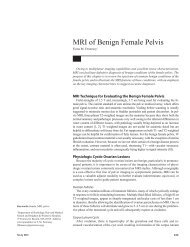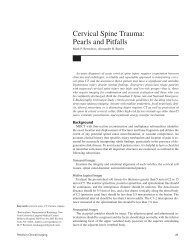Scientific Session 1 â Breast Imaging: Mammography
Scientific Session 1 â Breast Imaging: Mammography
Scientific Session 1 â Breast Imaging: Mammography
Create successful ePaper yourself
Turn your PDF publications into a flip-book with our unique Google optimized e-Paper software.
Monday<strong>Scientific</strong> <strong>Session</strong> 3—Genitourinary <strong>Imaging</strong>: AbdomenConclusion: There was no significant difference in measurements donemanually versus semiautomated measurement, with a paired t test p valueof 0.190. The semiautomated method also collected Hounsfield measurements,where they were only reported in one of 35 cysts. The semiautomatedmethod required fewer mouse clicks and fine mouse movements andhas the potential to save time. The software only gives a measurement if anedge is found, and because the method is still supervised, the radiologistcan throw away the measurement and do a manual measurement if theydisagree with the measurement markup produced by the software.021. Radiographic Changes and Nephrometry Downscoring ofPrimary Tumor in Patients Treated With Targeted Therapy forUnresectable Renal Cell CarcinomaShah, S.; Medsinge, A.*; Mohammed, S.; Rini, B. Cleveland Clinic,Broadview Heights, OHAddress correspondence to S. Shah (snsmriman@hotmail.com)Objective: We investigated the radiographic changes and impact onRENAL Nephrometry score of the primary tumor on contrast-enhancedCT in patients treated with sunitinib for advanced renal cell carcinoma(RCC) in the neoadjuvant setting.Materials and Methods: An institutional review board–approved HIPAAcompliantretrospective EMR review between February 2006 andFebruary 2007 identified 31 patients who enrolled in a phase II clinicaltrial for VEGF-targeted therapy in a cytoreductive nephrectomy setting.Patients had advanced RCC deemed unsuitable for initial nephrectomyand qualified for surgery after receiving VEGF-targeted therapy. Pre-VEGF-targeted therapy and precytoreductive nephrectomy contrast-enhancedCT scans were reviewed. RENAL Nephrometry scoring was usedbefore and after VEGF therapy to assess impact on radiographic surgicalcomplexity of each lesion. Response Evaluation Criteria in Solid Tumors(RECIST) and morphology, attenuation, size, and structure (MASS) criteriawere used to assess primary tumor radiographic response.Results: A total of 15 patients (male:female ratio, 13:2) underwent posttherapysurgical resection for 17 primary tumors. Three tumors wereunresectable due to tumor size; 13 due to proximity to vital structures:three as a result of inferior vena cava thrombosis and four due to lymphadenopathy.Most patients had multiple factors. On posttherapy CT,mean change in tumor long diameter was 30% and mean change in tumordensity was 34 HU. Compared with 13% prior to therapy, 83% oftreated patients had > 50% tumor necrosis (27% exhibiting > 95% necrosis).Degree of adenopathy decreased in all four patients with locallyadvanced disease, with complete resolution in one patient. Despite littleoverall impact on lesion Nephrometry score, tumor size reduction occurredin 93% and tumor abutment of sinus fat vital structures occurredin 70%. Response by RECIST (complete response + partial response)and MASS Criteria (FR) was seen in 33% and 47%, respectively. Onepatient had progressive disease by RECIST despite > 95% necrosis.Conclusion: As with treated metastases, VEGF-targeted therapy caused primarytumor necrosis, decreased attenuation, and decreased size. Despite littleimpact on tumor Nephrometry score, there was notable impact on lesionproximity to renal hilar vital structures following therapy. In the tested group,MASS criteria identified a greater number responders compared with RECIST.022. Reproducibility of Automated Renal Stone Volume VersusManual Linear Size Measurement at Unenhanced CT: Implicationsfor Clinical ManagementStanton, P.*; Pickhardt, P.; Borman, E.; Zelinski, N.; Lubner, M.; Patel,S.; Nakada, S.; Pozniak, M. University of Wisconsin, Madison, WIAddress correspondence to P. Pickhardt (ppickhardt2@uwhealth.org)Objective: Automated volume measurement of renal calculi at unenhancedlow-dose CT may be useful for serial assessment of urolithiasis.Our primary aim was to compare the reproducibility of automatedvolume measurement versus manual linear measurement using same-daysupine and prone unenhanced CT series.Materials and Methods: The patient cohort comprised 50 consecutiveadults (mean age, 56.4 years) with urolithiasis diagnosed by CT colonographyscreening. The largest stone per patient was assessed, treatingthe supine and prone series as mutual controls given the static stone size.Automated stone volume was derived using a modified coronary calciumscoring tool (Ziosoft, Redwood City, CA). Maximum axial lengths for eachindex stone were manually measured by three board-certified radiologists.Supine vs prone reproducibility for automated volume was compared withintraobserver supine-prone manual linear measurement. Interobservervariability for manual linear measurements of the same series (supine orprone) was also assessed by using the largest linear difference per stone.Results: Mean linear size and volume of the 50 index calculi was 4.5 ±2.7 mm (range, 1.8–16 mm) and 141.7 ± 456.1 mm 3 (range, 10.9–3167.5mm 3 ), respectively. Mean supine versus prone error for automated stonevolume was 16.3%, compared with an average unidimensional intraobservererror of 11.7% for manual axial measurement. Interobserver linearerror for the same CT series averaged 26.3%, whereas automated volumemeasurement of the same series should not vary.Conclusion: Automated renal stone volume is more reproducible thanmanual linear size measurement and avoids the often large interobservervariability seen with manual assessment. Because small linear differencesmay correspond to significant volume variation, automated volumemeasurement is more useful for the clinical management of urolithiasis.023. Adrenal Gland Material Density Analysis Utilizing DualEnergy Spectral MDCT: Intrapatient Comparison WithConventional Unenhanced MDCTLand, A.*; Morgan, D.; Weber, T.; Fineberg, N.; Lockhart, M.University of Alabama at Birmingham, Birmingham, ALAddress correspondence to D. Morgan (dmorgan@uabmc.edu)Objective: Compare conventional unenhanced (CU) MDCT of diseasedand normal adrenals using spectral MDCT (SMDCT) 140 keV images(“pseudo” unenhanced [PU]) and virtual unenhanced (VU) material densityimages to assess whether either could replace CU image acquisition.Materials and Methods: With institutional review board approval andHIPAA compliance, 417 consecutive subjects displayed 54 focal lesionsand 825 normal adrenals (363 subjects had one SMDCT, 23 hadtwo or greater SMDCT), measured at multiple slice thicknesses. MeanHounsfield unit (HU) density ± SD was measured on CU and PU images,and water concentrations (mg/mL) were measured on water-iodine*Will present paperA9
















